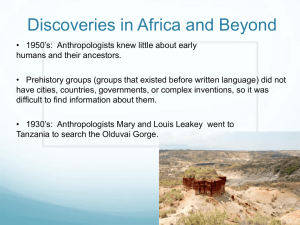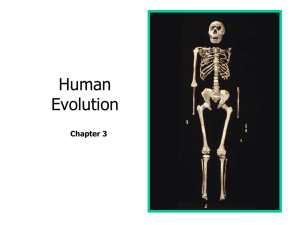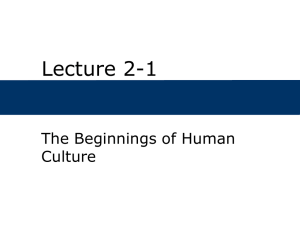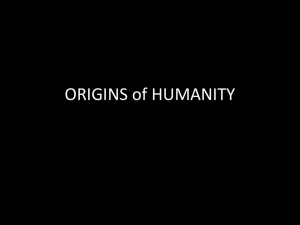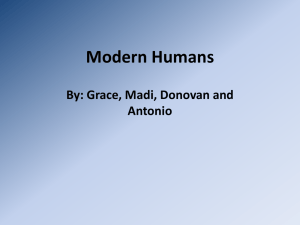Chapter 34 Presentation
advertisement
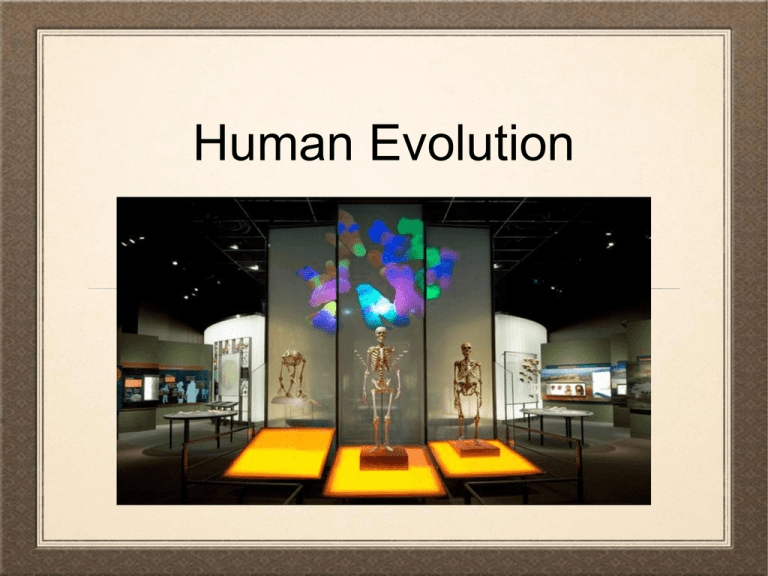
Human Evolution Misconceptions Avoid common misconceptions when thinking about human evolution. http://factsanddetails.com/media/2/20120201Charles_Darwin_as_an_ape_(1871).jpg Misconceptions First, chimpanzees didn’t ‘become’ humans or give birth to them. As with many of the other lineages of primates, many of these branches lived alongside one another for at least some of their respective histories. The various lineages acquired a variety of derived characters during their divergence from the common ancestor. Misconceptions Human evolution is NOT a direct ladder that leads from Homo sapiens directly back to the ancestral ape. http://2.bp.blogspot.com/-CfC3oepWZjk/UFln-UgyPdI/AAAAAAAACTo/G2PTqLFvkwg/s1600/IMG_001.jpg Misconceptions Homo sapiens ARE the end result of a highly branched evolutionary tree, and NOT a straight line path. Misconceptions The fossil record of human ancestry is incomplete and presents challenges. We cannot, with absolute certainty, determine the exact time when a certain species originated and when it became extinct. http://commons.wikimedia.org/wiki/File:Lucy_blackbg.jpg Misconceptions Early fossil record is fragmented and scarce because often times the organisms were not buried, rather they were killed by predators so the bones were spread about, and very few of them died in a location where they would be preserved. There are numerous ‘missing links’ so it cannot be ensured that the hypothesized evolution of hominids is completely accurate. http://commons.wikimedia.org/wiki/File:Lucy_blackbg.jpg Modern Primates A primate is a member of the mammalian order Primates. Modern primates evolved more than 50 million years ago, and most have gone extinct. http://thedispersalofdarwin.wordpress.com/category/natural-history/ Fossil evidence indicates small, insect-eating mammals with large eyes and small sharp teeth gave rise to the first primates-Algeripithecus is pictured to right. http://cdn.physorg.com/newman/gfx/news/hires/2009/theafricanor.jpg Baby Pygmy Marmosets http://www.factzoo.com/sites/all/img/mammals/monkeys/baby-pygmy-marmosets.jpg Modern Primates There are many groups of primates including humans, apes, monkeys, lemurs, tarsiers and they can be divided into either the New World monkeys or the Old World monkeys. http://www.sheppardsoftware.com/content/animals/animals/mammals/apevsmonkey.htm Modern Primates Old World Monkeys and Apes are native to Africa and Asia. They have non-grasping tails. They are catarrhines meaning they have noses with nostrils that face downward. http://ars.els-cdn.com/content/image/1-s2.0-S0960982212008068gr1.jpg http://www.sheppardsoftware.com/content/animals/animals/mammals/apevsmonkey.htm Modern Primates New World Monkeys are native to central and South America. Have prehensile tails. They are platyrrhines meaning they have flat noses with nostrils that face outward. http://ars.els-cdn.com/content/image/1-s2.0-S0960982212008068gr1.jpg http://www.sheppardsoftware.com/content/animals/animals/mammals/apevsmonkey.htm Major anatomical features defining humans as primates Old World monkeys include baboons, apes, orangutans, bonobos, chimpanzees, gorillas, and gibbons. http://animals.nationalgeographic.com/animals/mammals/chimpanzee/ http://en.wikipedia.org/wiki/File:Olive_baboon_Ngorongoro.jpg https://secure3.convio.net/sdzoo/images/adopt/adopt_bonobo.jpg http://news.discovery.com/animals/zooms/ape-skull-20-million-found-uganda.html http://4.bp.blogspot.com/_W90V87w3sr8/TMf7rliXGSI/AAAAAAAAAEk/keKwAtKZfoE/s1600/Orangutan2_468x619.jpg http://www.esa.org/esablog/research/those-gibbons-sure-can-wail/ http://www.huffingtonpost.com/elizabethgordon/guide-to-gorilla-trekking_b_1803602.html Major anatomical features defining humans as primates Monkeys, apes, and humans are known as Simian (and sometimes Anthropoiea) and differ from other primates in a number of ways. All Old World monkeys are catarrhines meaning they have ‘hooked’ noses with nostrils that face downward. http://crujonessociety.com/wordpress/wp-content/uploads/2009/02/monkeypa2_450x300.jpg Major anatomical features defining humans as primates All have grasping hands (opposable thumbs) and most have grasping feet. They have flattened nails instead of claws which enable the manipulation of tools. Primate eyes are located at the front of the face giving binocular vision and enabling depth perception. Major anatomical features defining humans as primates A primate’s shoulder joints allow for movement in 3 dimensions and are modified for upright posture. Parental care and long nurturing of offspring. Usually give birth to a single offspring. Major anatomical features defining humans as primates Other defining characteristics that are unique to humans: Humans have a larger brain and are capable of language, symbolic thought, artistic expression, and the manufacture and use of complex tools. http://upload.wikimedia.org/wikipedia/commons/d/db/Primate_skull_series_with_legend_cropped.png Humans also have reduced jawbones and jaw muscles, and a shorter digestive tract. Gorilla We have reduced canine teeth and flat faces. Neanderthal Australopithecus H. steinheimensis Homo erectus H. sapien http://upload.wikimedia.org/wikipedia/commons/thumb/b/b3/Craniums_of_Homo.svg/300px-Craniums_of_Homo.svg.png Hominid and hominin All early primates walked on four limbs. There are two terms that need to be distinguished: Hominid and Hominin. Hominid is a general term that describes all living and extinct Great Apes--humans, chimps, gorillas, etc. This group may have evolved about 7 million years ago. Hominin is the group of primates consisting of modern humans, extinct human species, and all immediate ancestors-including members of the genera Homo, Australopithecus, Paranthropus, and Ardipithecus. Hominid and hominin Hominins differ from other primates in many ways. 1. They are bipedal 2. They have S-shaped spines (as opposed to C-shaped). 3. Our arms are relatively short. http://www.fallingpixel.com/chimpanzee-skeleton-3d-model/39802 http://www.cedars-sinai.edu/Patients/Programs-and-Services/Spine-Center/Anatomy-of-the-Spine/Curves-of-the-Spine.aspx Hominid and hominin Hominins differ from other primates in many ways. 4. We have a bowl-shaped pelvis. 5. Our thighs angle under our bodies. http://www.healingourchildren.net/safe_natural_birth.htm http://en.wikipedia.org/wiki/File:Human_skeleton_front_en.svg Hominid and hominin Hominins differ from other primates in many ways. 6. Our spinal cord exits at the base of our skull. 7. We have smaller canine teeth than those of other primates. http://johnhawks.net/taxonomy/term/998 Hominin The majority of the information we’ve got about early hominins comes from fossils. Unfortunately, fossils of hominins are usually incomplete. However, scientists can use the fossils to identify and classify the species enabling various inferences such as where and when the species in question lived. http://commons.wikimedia.org/wiki/File:Lucy_blackbg.jpg http://www.dailymail.co.uk/sciencetech/article-1217400/Ardi-skeleton-Ethiopia-closestthing-missing-link-humans-apes.html Trends in the human lineage There are some major trends that define the many different species of the human lineage. For instance: Ardipithecus ramidus, or “Ardi” was small (about 50kg) and was at least partially bipedal. Ardi also had a protruding jaw. http://www.dailymail.co.uk/sciencetech/article-1217400/Ardi-skeleton-Ethiopia-closest-thing-missing-link-humans-apes.html Trends in the human lineage Australopithecus species lived between 4 and 2 million years ago and likely comprised a paraphyletic group. The earliest member of this group lived along side Ardi. Trends in the human lineage--australopithecus Australopithecus africanus was discovered in 1924 and lived between 3 and 2.4 million years ago. This species walked fully upright and had human-like hands and teeth. Its brain was about ⅓ the size of modern humans. They had a flatter face and large molars for a plant based diet. http://australianmuseum.net.au/image/Australopithecus-africanus-skull-side-view/ Trends in the human lineage--australopithecus In 1974, a 3.2 million year old fossil belonging to the species Australopithecus afarensis was found. It has since been termed “Lucy” and was about 1m tall. Trends in the human lineage--australopithecus Lucy was bipedal and had a brain about the size of a softball (about the size of a modern chimp’s brain), they have a long lower jaw, and had relatively long arm that enabled arboreal locomotion. http://www.prehistoricstore.com/item.php?item=1387 Trends in the human lineage--genus homo The earliest fossils belonging to the genus Homo include Homo habilis, Homo erectus, and Homo neanderthalensis. The Homo genus is currently dated to about 2.4 million years ago. http://www.theosophy-nw.org/theosnw/evol/ev-ibel2.htm Trends in the human lineage--genus homo In comparison to australopiths, Homo habilis had a short jaw and a larger brain volume, and they were the first to have the ability to use sharp, stone tools. http://www.prehistoricstore.com/item.php?item=1387 The smaller teeth were an adaptation for a meatier diet. http://hoopermuseum.earthsci.carleton.ca/emily/eighth.html QuickTime™ and a H.264 decompressor are needed to see this picture. Trends in the human lineage--genus homo Homo erectus is believed to have originated in Africa and is thought to be the first hominin to have migrated out of Africa. http://stryder.com/staid/migration_of_anatomically_modern_humans_bldg_blog_2008.jpg Trends in the human lineage--genus homo Homo erectus used more complex tools than H. habilis, meat was a significant part of the diet, and there were further changes in their teeth. http://web.mesacc.edu/dept/d10/asb/origins/hominid_journey/pictures/afar_hs.teth.gif A. afarensis H. erectus http://web.mesacc.edu/dept/d10/asb/origins/hominid_journey/pictures/afar_hs.teth.gif H. habilis http://www.macroevolution.net/homo-habilis-maxilla-oh-65.html H. erectus H. sapien Trends in the human lineage--genus homo The oldest fossils of hominins found outside of Africa are about 1.8 million years old and were found in Southern Russia (former Soviet Georgia), referred to as Dmanisi. The fossil may be that of Homo erectus. http://www.freerepublic.com/focus/f-news/1012772/posts Trends in the human lineage--genus homo Homo erectus may have migrated as far as Indonesia and is believed to have become extinct sometime between 200,000 and 50,000 years ago. http://www.freerepublic.com/focus/f-news/1012772/posts QuickTime™ and a decompressor are needed to see this picture. Trends in the human lineage--genus homo Homo neanderthalensis was discovered in 1856. Neanderthals comprise a fossil lineage that lived between 350,000 and 40,000 years ago. These hominins had unusually thick bones and a prominent brow. http://essayweb.net/history/ancient/prehistory_03.shtml Trends in the human lineage--genus homo They lived in Europe, the Near East, central Asia, and Southern Siberia. Their brain was as large as present-day humans, they buried their dead, and made hunting tools from stone and wood. http://www.dailymail.co.uk/sciencetech/article-1273904/Neanderthal-DNA-reveals-ancestors-DID-interbreed-extinct-species.html Trends in the human lineage--genus homo Homo sapiens are believed to have originated in Africa. Older species gave rise to later ones, and the oldest known fossils of our lineage have been found at two different sites in Ethiopia and were dated to 195,000 and 160,000. The early humans had less pronounced brow ridges than H. neanderthalensis and H. erectus. They have pelvic changes that support organs in walking. The legs are stronger and longer and the arms become shorter and weaker. The opposable toe is lost and the foot is more rigidly shaped and platform like. Trends in the human lineage--genus homo 1. Australopithecus afarensis 2. Australopithecus africanus 3. Homo habilis 4. Homo erectus 5. Neanderthal http://www.sculpturegallery.com/sculpture/hominid_series_of_five_skulls.html Trends in the human lineage--genus homo The oldest H. sapien fossils found outside of Africa are from the Middle East and date to about 115,000 years old. Humans are believed to have spread out of Africa in waves, and this evidence is supported by a variety of DNA studies. Humans are believe to have arrived in the New World about 15,000 years ago. Cultural evolution As time progressed, humans evolved further and so too did their various cultures. Cultural evolution refers to changes in the behavior of a species. For instance, as the Homo lineage progressed through time, the tools became more advanced, they branched further out from their ancestral land, and their diets changed. Cultural evolution Cultural evolution has spanned a long period of time. It began with primates being nomadic (hunter-gatherers). They progressed to an agricultural society whereby they settled in one spot and grew crops that could support a large population of people. Currently, we are in the industrial/post-industrial age with a society that has the ability to manufacture much of what it needs to survive. Cultural evolution It could be argued that our intelligence hasn’t changed much since nomadic times. What have changed are our technologies and experiences we have available to us. So, what led to these advances in human societies? Cultural evolution Largely, our advancements are due to the expansion of the human brain. Cultural evolution has changed far more quickly than genetic evolution of humans have. Our behaviors have changed greatly as have our abilities to change the environment around us (as opposed to changing to suit our environment).


